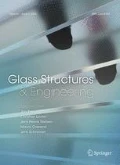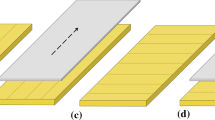Abstract
The bending strength of flat glass panels including the effects of their edges, is commonly determined by means of the four-point bending test method. This is an established and reliable method. However, when testing glass thinner than 3 mm, large deformation may occur. This means that the calculated stresses might not correspond to the actual, as the hypothesis behind the small deformation theory does no longer hold. Furthermore, it might occur that the specimen slips out of the supports, compelling the testing impossible. An alternative method, suitable for thin glass, consists of inducing an increasing curvature from flat until fracture. The curvature is to be constant along the length of the specimen at any time. The stress at fracture is calculated by knowing the corresponding radius or the applied bending moment. The equipment capable of performing this test is the clamp bender whereby the glass is held by two clamps at the specimen’s ends. Rotational and translational movement combine to uniaxially bend the glass as desired. This paper explores the validity of the clamp bender for testing thin glass by comparing the results generated by three different test setups developed at TU Darmstadt, TU Dresden and AGC. The three individually developed clamp bender setups follow the same principle, but present a few differences in actuation. Using these three clamp bender test setups, identical series of thin glass specimens were tested. The results showed that the glass fracture strength data coming from different setups match quite well one another. This paper discusses the different test setups and compares the obtained glass strength data. It contributes to the development of a universally applicable, simple and reliable test method for thin glass.














Similar content being viewed by others
References
ASTM E1300. Standard practice for determining load resistance of glass in buildings (2012)
Bartholomew, R.F., Garfinkel H.M.: Chemical strengthening of glass. In: Uhlmann, D.R., Kreidl, N.J. (eds.) Glass Science and Technology, Vol. 5. New York (1980)
Burggraaf, A.J., Cornelissen, J.: The strengthening of glass by ion-exchange. Part I stress formation by ion diffusion in alkali aluminosilkicate glass. Phys. Chem. Glasses 5, 123–129 (1964)
Cervio, M., Muciaccia, G., Rosati, G.: Impact performance of thin glass-polycarbonate composite panels. In: challenging glass conference proceedings, vol 5 Ghent: Belis, Bos & Louter, (2016)
Pfarr, D., et al.: Dünnglas-Verbundelemente mit additiv gefertigtem polymerkern: formfindung, fügeverfahren und untersuchung der Biegesteifigkeit. Wiley Online Library, 90, 507–516
Datsiou, K.C., Overend, M.: Artificial ageing of glass with sand abrasion. Construct. Build. Mater. 142, 536–551 (2017)
EN 1288-3 Glass in building-determination of the benging strength of glass—part 3: test with specimen supported at two points (four point bending) (2016)
Galuppi, L., Riva, E.: Experimental and numerical characterization of twisting response of thin glass. Glass Struct. Eng. 7(1), 45–69 (2022)
Hanig, J., Bernhard, W.: Experimental investigations and numerical simulations of innovative lightweight glass-plastic-composite panels made of thin glass and PMMA. Glass Struct. Eng. 6, 249–271 (2021)
Maniatis, I., Nehring G., Siebert G.: Studies on the strength of thin glass. In: IABSE symposium Report. Madrid, (2014)
Lambert, H., O'Callaghan, J.: Ultra-thin high strength glass research and potential applications. Glass Perform. Days. 95–99 (2013)
Louter, C.P., et al.: Adaptive and composite thin glass concepts for architectural applications. Heron 63(1), 199–218 (2018)
Maniatis, I., Nehring, G., Siebert, G.: Studies on determining the bending strength of thin glass. Struct. Build. 169, 393–402 (2014)
Overend, M., et al.: Glass reinforced glass. Glass Perform. Days. (2013)
Neugebauer, J.: Determining of bending tensile strength of thin glass. Challeng. Glass Conf. 5, 419–428 (2016)
Neugebauer J., et al.: Movable thin glass elements in facades. In: Challenging glass, vol 6, Delft, Belis, Bos & Louter (2018)
Oliveira Santos, F., Louter, C., Ramoa Correia, J.: Exploring thin glass strength test methodologies. Challeng. Glass Conf. Proc. 6, 713–724 (2018)
Schossler, N.: Thin glass as cold bent laminated panels in architectural applications. MSc Thesis, TU Delft, (2018)
Silveira, R.R., Louter, C., Klein, T.: Flexible transparency-a study on adaptive thin glass facade panels. Challenging Glass, vol. 6. Delft, Belis, Bos & Louter, (2018)
Pennetier, S., Ronfini, A., Stoddard J.: Advances in prototyping with ultra-thin glass. Glass Performance Days. Tampere (2019)
Peters, T., Jaschke, S., Schneider, J.: Thin glass in membrane-like structures-applications, modelling and testing. In: IASS annual symposium-form and force. Barcelona, International Association for Shell and Spatial Stractures, (2019)
Weimar, T., López, S. A.: Research on thin glass-polycarbonate composite panels. In: challenging glass. Vol. 6, TU Delft Open, (2018)
Zaccaria, M., Gillon, X.: scaling thin glass use to the architectural world. In: Glass performance days. Tampere, pp. 320–323, (2019)
Zaccaria, M., Overend, M.: Thermal healing of realistic flaws in glass. J. Mater. Civ. Eng. 28(2), (2016)
Zaccaria, M., et al.: Chemically strengthened glass for architectural applications. In: engineered transparency. Wiley, Dusseldorf, (2021)
Acknowledgements
The authors acknowledge Arthur Comblen, Jean-Philippe Biard, Jean-Marco Noiret for conceiving, designing and building the AGC's clamp bender.
Author information
Authors and Affiliations
Corresponding author
Ethics declarations
Conflict of interest
On behalf of all authors, the corresponding author states that there is no conflict of interest.
Additional information
Publisher's Note
Springer Nature remains neutral with regard to jurisdictional claims in published maps and institutional affiliations.
Rights and permissions
About this article
Cite this article
Zaccaria, M., Peters, T., Ebert, J. et al. The clamp bender: a new testing equipment for thin glass. Glass Struct Eng 7, 173–186 (2022). https://doi.org/10.1007/s40940-022-00188-8
Received:
Accepted:
Published:
Issue Date:
DOI: https://doi.org/10.1007/s40940-022-00188-8




